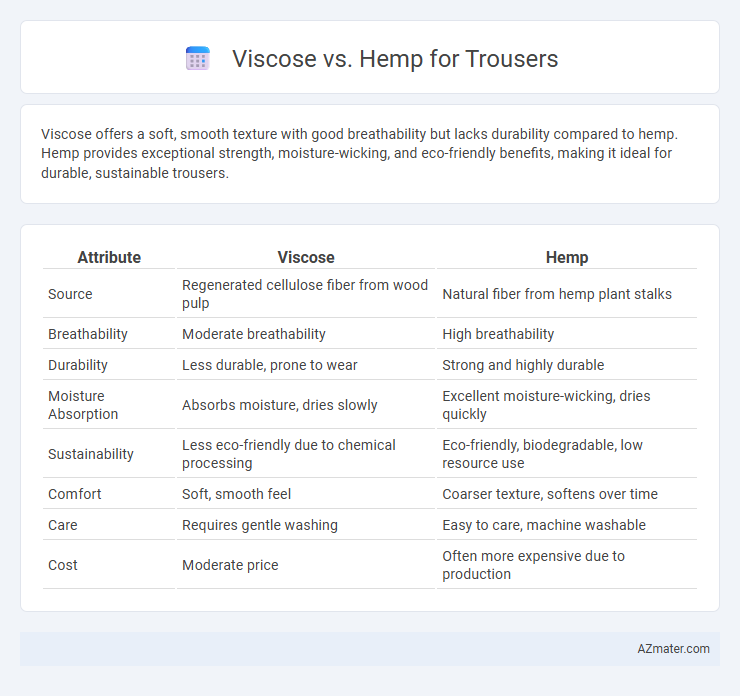Viscose offers a soft, smooth texture with good breathability but lacks durability compared to hemp. Hemp provides exceptional strength, moisture-wicking, and eco-friendly benefits, making it ideal for durable, sustainable trousers.
Table of Comparison
| Attribute | Viscose | Hemp |
|---|---|---|
| Source | Regenerated cellulose fiber from wood pulp | Natural fiber from hemp plant stalks |
| Breathability | Moderate breathability | High breathability |
| Durability | Less durable, prone to wear | Strong and highly durable |
| Moisture Absorption | Absorbs moisture, dries slowly | Excellent moisture-wicking, dries quickly |
| Sustainability | Less eco-friendly due to chemical processing | Eco-friendly, biodegradable, low resource use |
| Comfort | Soft, smooth feel | Coarser texture, softens over time |
| Care | Requires gentle washing | Easy to care, machine washable |
| Cost | Moderate price | Often more expensive due to production |
Introduction to Viscose and Hemp Fabrics
Viscose, a semi-synthetic fiber derived from cellulose, offers a soft, breathable texture commonly used in lightweight trousers with a smooth, silk-like finish. Hemp fabric, made from the fibers of the hemp plant, provides exceptional durability, natural resistance to mold and UV rays, and excellent breathability, ideal for eco-friendly and long-lasting trousers. Both materials present distinct environmental impacts and comfort levels, with viscose requiring chemical processing and hemp offering a sustainable, biodegradable alternative.
Material Origins: Viscose vs Hemp
Viscose is a semi-synthetic fiber derived from chemically processed wood pulp, primarily sourced from fast-growing trees like bamboo, beech, or eucalyptus, offering a soft, smooth texture ideal for trousers. Hemp, on the other hand, is a natural bast fiber obtained from the stalks of the Cannabis sativa plant, known for its durability, breathability, and eco-friendly cultivation with minimal water and pesticide use. The contrasting material origins influence the sustainability, texture, and performance of trousers, making hemp a more renewable and biodegradable option compared to viscose's environmentally intensive production.
Environmental Impact Comparison
Viscose production involves significant chemical processing and deforestation, leading to high environmental pollution and resource-intensive water use, impacting ecosystem health. Hemp cultivation requires minimal pesticides, grows rapidly with low water consumption, and improves soil health through natural phytoremediation, resulting in a substantially lower environmental footprint. Choosing hemp over viscose for trousers supports sustainable agriculture and reduces deforestation and chemical waste, contributing positively to climate change mitigation.
Breathability and Comfort
Hemp trousers offer superior breathability due to the fiber's natural porous structure, allowing better air circulation and moisture-wicking compared to viscose. Viscose, while soft and smooth, tends to retain heat and moisture, making it less comfortable in hot or humid conditions. Hemp's durability combined with its breathability ensures long-lasting comfort, especially for active or warm-weather wear.
Durability and Longevity
Hemp trousers exhibit superior durability due to their strong, coarse fibers, resisting wear and tear far better than viscose. Viscose, made from regenerated cellulose fibers, tends to weaken with frequent washing and prolonged use, leading to shorter garment lifespan. For long-lasting trousers, hemp offers enhanced longevity and maintains structural integrity over time.
Style, Drape, and Fit
Viscose trousers offer a smooth, silky texture with excellent drape, enhancing a sleek and tailored fit that flatters body contours effortlessly. Hemp fabric provides a more structured and durable feel with a natural, slightly coarse texture, resulting in trousers that maintain shape while offering breathable comfort and a casual, laid-back style. Both materials cater to different fashion priorities: viscose emphasizes elegance and fluidity, while hemp highlights ruggedness and eco-friendly appeal.
Maintenance and Care Requirements
Viscose trousers require gentle washing techniques, preferably hand-washing or delicate machine cycles with cold water to prevent shrinking and fabric damage. Hemp trousers are more durable and can tolerate machine washing at higher temperatures but may need slower drying to avoid stiffness. Proper maintenance of hemp ensures longevity and breathability, while viscose demands careful handling to maintain softness and prevent wear.
Cost and Market Availability
Viscose trousers are generally more affordable due to mass production and widespread availability in global markets, making them a popular choice for budget-conscious consumers. Hemp trousers, while growing in popularity for their sustainable and durable qualities, tend to be priced higher due to limited production scale and less market penetration. The availability of viscose trousers far exceeds hemp, which remains a niche product mainly found in eco-friendly and specialty apparel stores.
Sustainability and Ethical Factors
Hemp trousers offer superior sustainability due to hemp's rapid growth, low water requirements, and minimal need for pesticides, making it an eco-friendly fiber compared to viscose, which involves chemical-intensive manufacturing processes that can harm the environment. Hemp production supports ethical fashion by promoting soil health and biodiversity, while viscose often relies on unsustainable wood sources and toxic chemicals, raising concerns about deforestation and worker safety. Choosing hemp trousers aligns with sustainable and ethical values through reduced environmental impact and better labor conditions.
Choosing the Right Fabric for Trousers
Viscose offers a smooth, lightweight drape ideal for stylish, breathable trousers, while hemp provides exceptional durability and natural moisture-wicking properties perfect for long-lasting, eco-friendly wear. Hemp fabric has superior resistance to wear and UV rays, making it suitable for rugged, outdoor trousers, whereas viscose emphasizes comfort and a silky texture for formal or casual settings. Selecting between viscose and hemp depends on prioritizing sustainable strength and breathability or soft hand-feel and fluid garment structure for trousers.

Infographic: Viscose vs Hemp for Trousers
 azmater.com
azmater.com